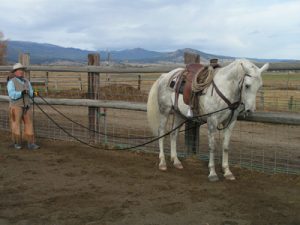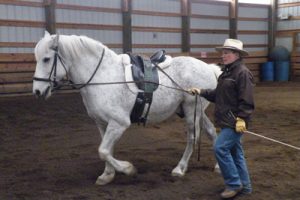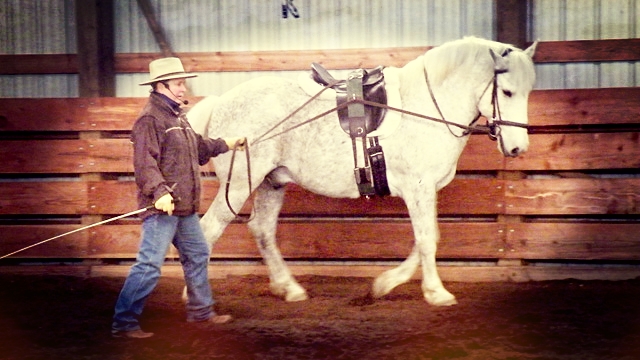I was extremely fortunate to grow up with both saddle horses and big ‘ol draft horse teams. Sitting up behind the collar and hanging on to the hames as my brothers walked the draft horses back from helping to feed off the morning hay to the cows was always a great pleasure. We have pictures of birthday parties with about eleven little kids sitting from ears to tail on a good workhorse that just seemed to know how to take care of every pair of kicking, gripping little legs, and not be bothered one bit!
The last several years I have found great benefit in driving my saddle horses on long lines. As I have pursued an understanding of true Classical training principles, with a desire to create a willing relationship in lightness with my horses, I have discovered an ever increasing depth that can be achieved by work in hand on the long lines. For the human, driving on the long lines helps develop feel and creates a good awareness of how the horse’s feet move, along with how your body energy needs to position to achieve certain movements. For the horse, driving encourages self-carriage, leadership, and can often be the beginnings of collection and engagement. The picture of a horse carrying a “soft feel,” picking his posture up due to correct development of the neck muscles, moving through the back, and engaging the hindquarters, is truly breathtaking. So let’s get started…Put on your walking shoes and get ready to do some of the best riding you may ever accomplish, by learning to drive your horse on the long lines.
The Equipment
You don’t have to have anything fancy to set your horse up for driving on the long lines. However, I have found that certain pieces of equipment facilitate both the horse and the human in understanding the maneuvers to be developed in hand on the long lines. So I have divided my suggest list into two categories, depending on what you may already have in your tack room, and how you will eventually use the equipment.

Cowgirl Trappings:
• Headstall set-up with snaffle bit or similar with broken mouth piece, curb strap, slobber straps (not required), two 22-ft. ring ropes, and two lightweight carabiners. I use a 5/8-inch yacht-braid rope
• Saddle and pad
• 8-10 ft. length of cord or string, even baling twine works!
Classical Trappings:
• Lunging caveson
• Headstall set-up with snaffle bit or similar bit
• Surcingle
• Driving lines (I use a set that are cotton webbing material, 24 ft. total, with a buckle in the middle, and the first 4 ft. are rounded)
Prerequisite – Before You Begin
Before we get into how to set your horse up for long line driving and work in hand, there are several questions you need to ask yourself and your horse:
• Can your horse accept a rope on any part of his body, under his tail, around his flank, between his legs?
• Does your horse accept the snaffle bit softly, and can he give a “soft feel” by relaxing at the poll and jowl?
• Can your horse handle movements and positioning from where you are located behind him and comfortably change the eye in which he is seeing you from right to the blind spot to left eye?
• How’s your health? Driving on the long lines is great exercise. If you have a heart condition or breathing concerns, you may want to find a human partner to assist you so that you can take a break!
Getting Set Up – “Cowgirl”
Begin by creating a “Cowgirl” surcingle. The purpose is simply to keep the lines close to the horse. With your horse saddled, start by tying the stirrups together under the horse’s belly. Try to position the string so that it attaches to the inside of the stirrup, creating a ring or tunnel through which the lines are going to flow.
Next, set-up your long lines on your snaffle bit headstall, before you put it on the horse. Our goal is to have two 22-ft. lines, with one running from each of the slobber straps, or attached via the carabiner between the ring on the line and the bit. (Note: If you are using the slobber straps to attache the line to the bit, do this prior to bridling. If you are using the snap, you can bridle, then attach the lines.) Coil your two lines neatly so that you are prepared to bridle your horse without a tangled mess…it’s a lot of rope! As you bridle, and begin to set-up the “Cowgirl” surcingle, remember that the lines have quite a bit of additional weight. Be conscientious of how you are treating the horse’s delicate mouth.
Once you have politely bridled your horse, take the left long line, and feed it through the left stirrup, neatly coil it back up, and place it on the saddle horn. Now move around the front of your horse to the right side, and accomplish the same task of feeding the line through the stirrup. Your are about ready to start…Find your left line from off the saddle horn, feeding it politely down the left side of the horse, and position yourself slightly behind the right hip, with the left line in your left hand and the right line in your right hand.

Getting Set Up – “Classical”
Since ancient times, true Classical Dressage training incorporated work in hand on the long lines. A surcingle will keep the lines close to the horse, and also afford you several options on how to attach the lines, both running through the rings or attached to the ring and running the line through the bit or caveson. Many Classical trainers will start the use of the long line attached to a lunging caveson, to be vigilant regarding softness of the mouth with a bit. In setting up the lines be careful to attach the line to the bit or caveson after you pass it through the ring on the surcingle.
Positioning and How to DRIVE Your Intentions
Remember the old cowboy movies where the stagecoach driver took both lines and slapped them up and down with a huge “HAYAAAA” to get the horses to go forward. Well, this is NOT like that! In long-lining we will have very specific messages passing down the lines, and it will be critical that we are clear and consistent in relaying our intentions. Before you ask the horse to move forward, review the picture and purpose of a supporting rein on the outside of the horse, and an active rein to the inside of the bend. The outside line, or line closer to the wall is most often supportive. You should have a feel, a caress, and a slight squeeze in this line. It does not direct the horse, but rather makes a suggestion…it supports the movement and requests that the horse seek balance. The inside line is active and it can give direction by sending energy to where you want the horse to go in “Cowgirl” methodology. The whip and/or a human partner can help establish the intention of the inside rein in “Classical” methods. You can use the inside rein to drive the energy up and forward in kind of a “skip-a-rope” motion, like you were skipping a stone sideways across the water. The inside rein does have a feel on it, but gives and releases the pressure when the horse responds to the request, while the outside, support line most often maintains a caress.
I hold the lines most of the time in the same way that I would hold my reins: up over the thump, little finger down, with the line running out the bottom, between my ring finger and little finger, towards the horse’s mouth. Old-time drivers of draft horses, such as my dad, held the lines over the top of their pointer finger. This may work well for you at certain times, but I like to be conditioning my muscle memories for riding postures whenever possible. Play around with hand positioning, and I think you will understand how each position uses a different set of muscles, and may cause undesirable braces in your body.
As you prepare to ask your horse forward, review the “Horseman’s Protocol.” (Become present; Breath; Think; Picture; Allow; Reward) It is even more important on the ground than in the saddle! Take a deep breath, and see your horse moving forward to the right, since you are at his right hip in this illustration. Now wake up your right line, with a little sideways skip of your rope or point of your whip, send energy forward and towards your horse’s right hip and flank. A human partner can greatly assist you with the whip to first motivate for forward momentum. In a classical pursuit you rarely would spank with the line, but rather use the whip to assist. It may take a bit for him to understand this new positioning and feel, but soon he will be traveling out in front of you as you walk along slightly to the inside of his right hip. Don’t get too close, but equally so, don’t get out at the very ends of your lines!
As you progress forward, see yourself as the cart, or sitting on the cart, and the horse pushing forward into the collar. Keep your shoulder blades back – balanced over your hips, bend your elbows a bit, and think about bringing your belly to your hands. Drive the horse forward with your intentions and active line. Try not to push with your arms, causing huge scoops in the lines between your hands and the horse’s mouth. Equally, try not to find yourself water skiing, with straight arms. Believe me, if your horse takes off while you are in this posture, you are in for a ride! The idea is to invite the horse to PUSH from his hindquarters, lifting his belly, rounding his back, and you capturing the energy, this “FEEL,” back in your hands.
Specific Maneuvers and Exercises
Pretty much all of the riding maneuvers and patterns you may want to accomplish in the saddle are achievable on the long lines. In fact, in many cases I prefer to teach the maneuver on the ground, with long lines first, and then transfer the feeling for both horse and rider easily to the saddle.
Start with the basics:
• Forward on a circle
• Change of direction towards the center of the arena
• Change of direction towards the wall, or roll back
• Back up straight, to backing up on a circle
• Leg yield – forward and sideways on the diagonal
• ide pass – nose to the wall, sideways at a 45-degree
angle to the wall, moving away from the bend
• houlder-in
• Haunches-in (trevers) and Haunches–out (renvers)
• Half-pass
With each of these maneuvers you will most likely explore some frustration until you discover the positioning you need to have in order to send your energy and convey to the horse your intentions. It’s OK to be frustrated! Hang in there, or seek some helpful advice from someone who has driven on long lines a bunch.
The rewards to long line driving your horse are truly immense. You will develop a much better feel for the horse through your reins, and begin to understand the importance of the outside – support rein. You will see how the feet move, how rhythm, timing, & balance affect movement. You will gain a greater understanding of positioning of your energy and posture to affect the movement outcome. Your horse will begin to develop self-carriage and self-impulsion, while carrying a beautiful posture in lightness. He will also take on a self-confidence, and be looking for your leadership. Warning: Driving on long lines is addictive! The results, the fun, and the exercise are well worth the effort.
[ux_custom_products cat=”magazine-subscriptions” products=”6″ columns=”3″ title=”Want more? Subscribe!”]


